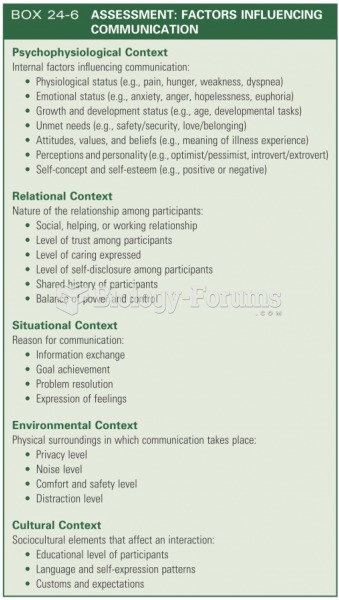Answer to Question 1
Because cultures give different definitions of such basics of interaction as values and norms, people raised in two different cultures can clash in various ways.
a. Personal space requirements: Space operates as a language just as time does. The study of cultural space requirements is known as proxemics. In all cultures, the distance between people functions in communication as personal space or personal territory. In the United States, for example, for intimate conversations with close friends and relatives, individuals are willing to stay within about a foot and a half of each other. However, in many cultures outside the United States, closer personal contact is accepted, or greater distance might be the norm.
b. Body language: The study of body language is known as kinesics. Body language is not universal, but instead is learned from one's culture. Even the most basic gestures have varying cultural meanings-the familiar North American symbol for okay means zero in France, money in Japan, and an expression of vulgarity in Brazil. Similarly, eye contact, posture, and facial expressions carry different meanings throughout the world.
c. Translation limitations: Words in one language do not always have an equivalent meaning in other languages, and the concepts the words describe are often different as well. Translators can be helpful, but keep in mind that a translator is working with a second language and must listen to one language, mentally cast the words into another language, and then speak them. This process is difficult and opens the possibility that the translator will fall victim to one or more cultural barriers. Even if you cannot speak or write another language fluently, people from other cultures will appreciate simple efforts to learn a few common phrases.
Answer to Question 2
Because cultures give different definitions of such basics of interaction as values and norms, people raised in two different cultures can clash in various ways.
a. Ethnocentrism: Problems occur between people of different cultures primarily because people tend to assume that their own cultural norms are the right way to do things. They wrongly believe that the specific patterns of behavior desired in their own cultures are universally valued. This belief, known as ethnocentrism, is certainly natural; but learning about other cultures and developing sensitivity will help minimize ethnocentric reactions when dealing with other cultures.
b. Stereotypes: We often form a mental picture of the main characteristics of another group, creating preformed ideas of what people in this group are like. These pictures, called stereotypes, influence the way we interact with members of the other group. When we observe a behavior that conforms to a stereotype, the validity of the preconceived notion is reinforced. We often view the other person as a representative of a class of people rather than as an individual. These stereotypes can interfere with communication when people interact on the basis of the imagined representative and not the real individual.
c. Interpretation of time:
The study of how a culture perceives time and its use is called
chronemics
. In the United States, we have a saying that time is money. Canadians, like some northern Europeans who are also concerned about punctuality, make appointments, keep them, and complete them, and waste no time in the process. In some other cultures, time is the cheapest commodity and an inexhaustible resource; time represents a person's span on Earth, which is only part of eternity. To these cultures, engaging in long, casual conversations prior to serious discussions or negotiations is time well spent in establishing and nurturing relationships. On the other hand, the time-efficient American businessperson is likely to fret about wasting precious time.







